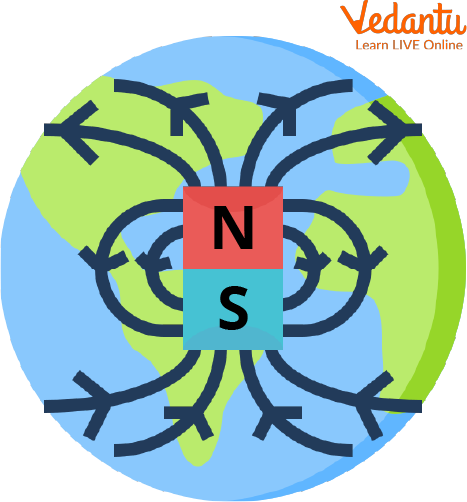




What is a Magnetic Field?
Were you surprised too when you first saw how a magnet works? It’s not magic, it’s science! Let’s learn about the properties of magnetism and what a magnetic field is. A magnet is a piece of metal or rock that pulls specific kinds of metals towards itself. The force or field of magnets is called magnetism. There are three types of magnets - temporary magnets, permanent magnets, and electromagnets.
Temporary magnets - when the magnetic force is removed, the object gradually loses its magnetism. Once permanent magnets are magnetised, they do not easily lose their magnetism. Electromagnets are used when a really strong magnet is needed.
Magnetic Force - Definition
Magnetic force is caused due to the motion of charges. The north poles and south poles are attracted to each other. Unlike poles attract each other. Plastic, rubber, water, glass, or non-magnetic materials are not attracted toward a magnet. Objects such as nails, nuts, screws, and rods are magnetic materials, hence they are attracted to magnets. Objects that are rich in iron, cobalt, and nickel are strongly attracted to magnets. Scientists call these metallic elements ‘ferromagnetic’ because of their strong attraction.
Earth’s Magnetism (Properties of Magnetism)

Earth’s Magnetic Field
The region surrounding a magnet, where magnetism can be traced, is called the region’s magnetic field. The Earth possesses a magnetic field, it works as if a permanent bar magnet is fitted inside it.
The Earth is like one massive magnet. The Earth’s core is a mix of iron and nickel which gives it its very own magnetic field. Magnets are really useful, they are used to make a tight seal between the frame of a refrigerator and its door. Magnets are also used for storing data in computers. They power speakers in devices such as headphones and stereos.
What Makes a Magnet?
Inside a piece of steel are large numbers of tiny magnetic regions called domains. These domains are mixed up so that their effects cancel out and the steel does not get magnetised. If the domain points in the same direction, the steel turns into a magnet. The end that the north poles of the domains point towards becomes a north pole and the other end is a south pole.
Aurora - A Beautiful Phenomenon

Aurora Responds to Earth’s Magnetic Field
The Earth’s magnetic poles attract charged particles emitted by the Sun. When the particles clash with other gas particles in the atmosphere, coloured light gets radiated.
What are the Uses of a Magnet?
Magnetic Tape
A cassette tape contains plastic tape with a coating of iron oxide or chromium dioxide. Magnetic patterns can be applied to the tape by the head of a tape recorder. This causes a change in electrical sound signals, turning them into a magnetic field which induces patterns of magnetism on the tape. While replaying, the magnetised tape causes electrical signals in the head. These are reproduced as sound.
Burglar Alarm:
On the door, a permanent magnet is mounted. A reed switch is mounted on the door frame. When the door is in the closed position, the magnet causes the upper two magnetic iron strips to cling together. When the door is opened by the burglar, the magnet moves away and the centre strip gets sprung back. It touches the non-magnetic contact below, completing the circuit and activating the alarm.
Electromagnetism:
Many things around us, such as speakers, electric bells, horns, and motors, use electricity to make magnetism. An electric current always produces a magnetic force. A magnet created in this way is called an electromagnet; magnetism made in this way is called electromagnetism.
Summary
A magnet works over a distance - it doesn’t need to touch an object to attract (pull) it. A magnet has a north pole and a south pole, both. The magnetic force of magnets flows from the north pole toward the south pole. If you try to push the south poles of two magnets together, they repel each other. Two north poles also repel each other, which means like poles repel each other.
FAQs on Magnetism
1. If magnets can work without electricity, why would anyone want to use a magnet that works only when a current passes through it?
Permanent magnets do not need electricity but electromagnets can do many things that permanent magnets cannot. You can switch an electromagnet on and off so that it works only when you want to. An electromagnet is a type of magnet where the magnetic field is produced with the help of an electric current. Electromagnets are usually wires wound into a coil shape. The magnetic field of an electromagnet can be controlled and changes quickly just by controlling the amount of electricity passing through the wires, this is one major advantage of an electromagnet over a permanent magnet.
2. How do maglev trains work?
Magnetic levitation (maglev) trains give a very smooth and quiet ride. An electric current passes through electromagnets that are fitted on the track and on the train. The magnetism produced lifts the train upwards. A big difference between a conventional train and a maglev train is that maglev trains do not even have an engine! The engine is replaced by a similar, greener alternative that does not require fossil fuel to run. As children, we have played with magnets and we know that like poles repel and opposite poles attract. This is the principle on which maglev trains actually work.









